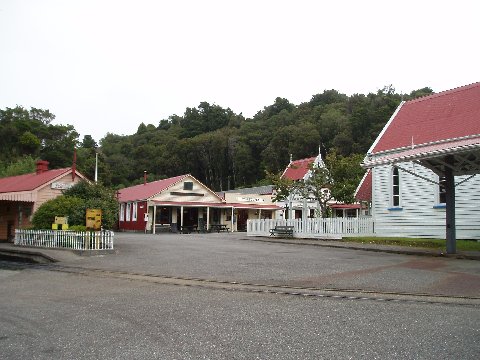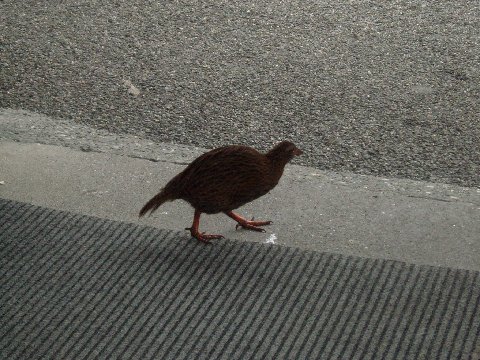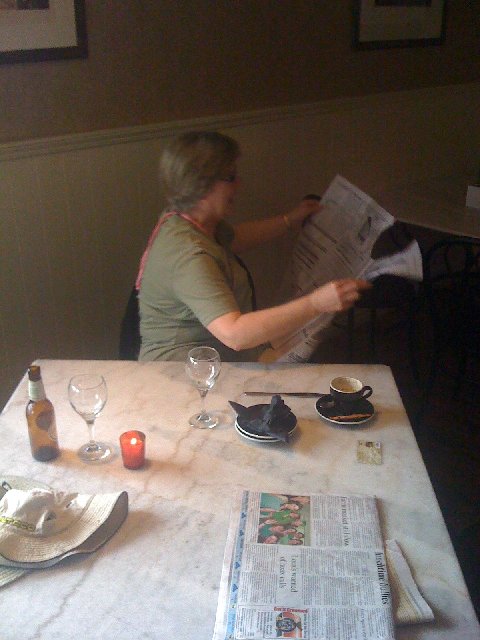Still More
I returned in one piece from my run up the Pass, just in time for us to walk into the town, which by now Brenda had scoped out thoroughly. She’d found us a good restaurant with a balcony dining area overlooking the Tasman so that we could watch the sun setting on Australia while eating our “wild food” dinner. Apparently Hokatika has a “wild food” festival, which we had just missed, (explaining the large inflated blue boar on top of one of the buildings) in which native and just plain strange foods are featured. I guess we got the leftovers for dinner. I had kangaroo served over unknown and largely unrecognizable vegetables and Brenda had crocodile (which could have been reversed, if the croc had any say in the matter) in blueberry jus. It was all good, though in honest I have to say that ‘roo tastes a lot like beef and croc’s quite similar to chicken. The veggies, whatever the heck they were, proved very tasty.
That night the rain moved in with a vengence. By morning it was raining hard with high cross winds. We set out, after breakfast at “Eats” café, headed north.
On our way out of Hokatika we stopped in at the Shanty Town Historic Site where a gold rush era mining community had been recreated. We went in to tour the old village and began with the Chinatown section. Apparently the Chinese miners came in droves to New Zealand, Australia and the western gold fields of the US because economic conditions were terrible in their native country in the middle 1800’s.
The miners lived in extremely harsh circumstances. A typical shack in which they lived was little more than a rough board cubical with some sort of net hammock strung at one end and a cooking fire at the other. In some of the historical documents however New Zealanders and other Europeans who visited the camp marveled at the extreme cleanliness with which the Chinese miners’ kept their living conditions.
The Chinese came in and with hard work and ingenuity reopened mine sites that had been abandoned by the Europeans as played out. The Oriental workers used very labor intensive and intelligent techniques to extract even more gold from what others left behind.
We also toured the hospital for the old village, which could more accurately be described as a torture chamber. I’m sure it was state of the art medicine for its day but when one considers that Doctors then actually didn’t know very much about the human body and how it really worked at that point and certainly very little about causes of disease, it is amazing that anyone survived.
The old library in the village was probably the grandest edifice of all. It displayed a reverence for learning and the printed word.

(Shantytown village)
We had coffee and a cookie in the tea room and quickly were joined by a Weka bird which looks like an oversized kiwi bird. The creature strolled in to the tea room as if he owned the place and began pecking for crumbs on the carpet. In the gift shop attached to the tea room was a large gray cat who the shop clerk said had come as a kitten and taken up residence. He seemed remarkably uninterested in the large bird strolling around just 10 -12 feet away. The shop girl said that the cat had a routine of three different places in the village where he got fed every day and he liked to hang around the shop where lots of people would come in and pet him. It’s a rough life.

(The Weka bird goes off in search of more generous tourists)
Back on the road again, we were soon on the seacoast, winding our way along the edge of the cliffs overlooking the Tasman Sea, which was angry indeed. The winds were whipping the waves into a violent froth and flinging them up onto the shore and rocks far below us. We were trying our best to keep on that thin ribbon of asphalt while crosswinds of 40 mph or more tried to defeat that goal. From my perspective the next 50 or so miles of New Zealand looked exactly like some of Ireland that I tried to see a few years ago….one lane of wet tarmac with a white line in the center and another at the shoulder with me desperately trying to keep the bike between those two lines. I’m sure there was scenery off to the sides, but I didn’t see it. The wind had us drifting from one line to the other and back again as we tried to make slow forward progress. There was nowhere to stop and in most places, not even a wide spot to pull over so going forward was the only option on the table. When we finally reached Westport, I knew it was time to stop for the night…whatever time it happened to be.
In Westport we found apparently one of the last rooms in town at the Palm Court motor lodge. It was still pouring rain with high wind when we walked into town, approximately a half mile to find a restaurant. Most of the places were closed. This is not a resort town but an industrial village with factories and “real” stores. Finally at the far end of town from where we were staying we located the Portabelo bar and grill which turned out to be an exceptionally nice restaurant. Brenda had a veggie pizza with two glasses of wine and I ordered the pork which turned out to be one of the best meals that I have had in a long time. Everything was prepared and seasoned perfectly. I ordered for the first time since we been here a not local beer, one called “Little Creatures” from western Australia. It turned out to be the best beer of the trip.
After dinner we were given a newspaper that another diner had left behind and I proceeded to entertain the staff and other diners by sitting fire to it. There was a candle in the middle of the table and as I read the paper I suddenly realized that the upper end of it was on fire. I dropped the burning paper on the marble table top and beat out the flames with my hat much to the amusement of Brenda and the others present.. I told them all to watch for my next act but no one seemed to think that I could top that one.

Brenda reading the remnants of my fire act